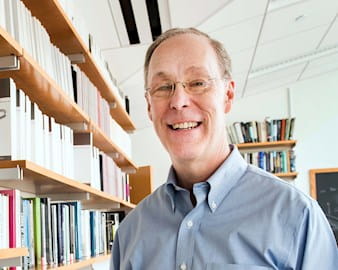
1975
Graduated from Brown University with a bachelor’s degree in economics
1975
What is the proper role of financial institutions? What happens when banks collapse, and how can we prevent such catastrophes? By shedding light on these and other vital questions, Douglas W. Diamond, the Merton H. Miller Distinguished Service Professor of Finance at Chicago Booth, has helped lay the groundwork for modern banking theory and transformed the way people think about banking.
Diamond didn’t set out to influence monetary policy. Raised in Chicago’s Hyde Park neighborhood by a single mother, he originally planned to be a molecular biologist. But when he started college at Brown University, he discovered that he didn’t actually like molecular biology. That’s when he turned to economics. A course on Milton Friedman and Anna Schwartz’s seminal A Monetary History of the United States sparked his interest in the bank failures of the Great Depression.
“It turned out I was very good at economics,” he says. “It seemed a little too easy, but then I realized that was a good thing.”
One of the two papers cited by the Nobel Foundation was from Diamond’s doctoral dissertation. That paper, “Financial Intermediation and Delegated Monitoring,” appeared in the Review of Economic Studies in 1984. It explained that the highly levered structure of banks (financing themselves with deposits that are debt) is required when their monitor borrows on behalf of their depositors. In addition, banks must be large and well diversified. This was the first explanation of this important structure that banks use. The delegated monitoring generated a conflict of interest between bankers and depositors, while the monitoring of borrowers reduced the conflict of interest between banks and the borrowers.
Diamond continued to work on understanding the structure and importance of banking once he finished graduate school at Yale. He was interested in how the bank failures in the United States in the 1930s contributed to the severity of what could have been a major recession and turned it into the Great Depression, but felt Friedman’s and Schwartz’s description of the damage from the bank failures appeared to be incomplete.
This concern led to a joint project to understand the instability of the banking system with Philip H. Dybvig, a fellow graduate student of legendary economist Stephen Ross.
“Steve didn’t take appointments for his students—you had to sit outside his door and hope he had some free time,” Diamond says. “So Phil and I sat on the stoop talking about various things, and we decided we should do a project together.”
That project resulted in “Bank Runs, Deposit Insurance, and Liquidity,” a groundbreaking paper that appeared in the Journal of Political Economy in 1983. The paper introduced the influential Diamond-Dybvig model, a framework that explains the factors that cause bank runs, outlines the consequences of such failures, and explores ways to stop them from happening.
“In the old days, people thought bank runs had something to do with not having enough currency in the vault of a bank,” Diamond says. “The point of all of my models is that even in a modern financial system that doesn’t have issues of not enough currency, you can still have bank runs.”
In 2022, the Royal Swedish Academy of Sciences cited both papers in awarding the Nobel Prize in Economic Sciences to Diamond along with Dybvig and former Federal Reserve chair Ben Bernanke for improving “our understanding of the role of banks in the economy, particularly during financial crises.”
“Financial crises and depressions are . . . the worst things that can happen to the economy,” said John Hassler, a member of the Economic Sciences Prize Committee, in an interview following the prize announcement. “We need to have an understanding of the mechanisms behind those and what to do about it. And the laureates this year provide that.”
—This article includes material previously published by the University of Chicago.

“The University of Chicago is one of the few places where senior faculty keep doing research at more or less the same rate they did when they were junior faculty. And that’s because we all support each other.”
—Douglas W. Diamond
Diamond’s prize-winning work has helped shape the world’s understanding of financial crises, the role of financial institutions in society, and the importance of keeping banks from collapsing.